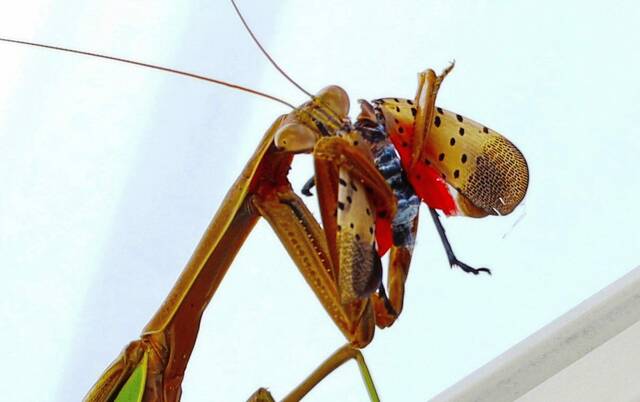Four years ago I had the dubious pleasure of meeting Lycorma delicatula (or the Spotted Lanternfly, a.k.a. SLF) at my parents’ house during the COVID lockdown. At that time, there had not been many sightings in western Pennsylvania, even though the bug had been present in eastern PA since 2014. Since then, I have seen an explosion of these bugs in our neck of the woods, and they have expanded their range further north into New York State as well. Attempts to handle this unwelcome guest are frequently as ineffective as they are harmful to surrounding plants and animals, which is why it seemed like a good time for an update, four years after my last post on the subject. [1]
Needless Massacre?
The summer before last, I attended a family day event at my husband’s workplace. Standing in a lengthy line, in the sun, waiting to get a family photo, our three-year-old nephew started to get a little bored. Hoping to keep him entertained, I asked him if he wanted to go do something important with me. The courtyard was swarming with adult lanternflies, so I started a competition with him to see who could squash more. For the record: I hate killing any living things, and I have only regularly made exceptions for things that are actively biting me (e.g. mosquitos) and things that represent potential damage to assets (e.g. termites). But knowing that these bugs are causing real damage, and knowing that he was definitely going to need something to do while everyone else waited in line, we set to smushing. Several other kids from the line joined us.

Photo credit: Darcy Osby
Worse than the feeling I get from killing Spotted Lanternflies myself was the feeling I got from encouraging my impressionable little nephew to do the same. On the rare occasions we spend time together, I try to feed his curiosity about the world, particularly in caring for and respecting nature. When he asked me why we were supposed to kill these bugs, I struggled to explain the danger invasive species represent without also unintentionally planting seeds of xenophobia. He cried when they flew away from him; I explained that they were scared of him and didn’t want to die. He then squashed a beetle and proudly showed me; horrified, I explained that it wasn’t one of the ones we were trying to get and that he should be gentle with everything else. It was heartbreaking to think that years from now this killing spree might be his first memory of me.
But the question worth asking at this point is whether the frequent stomping of the SLF is warranted. In the four years since I last did any research, others have been asking good questions about what actions we’re taking and what the consequences are. It is important to remember (as I frequently note on this blog, regardless of the subject) that the scientific process does not have the answers; it is a method for arriving at answers. Depending on what questions we ask and how we gather information to answer them, our understanding of an issue will continue to evolve over time. Most of us are not used to watching the scientific process in real time, which is why not having concrete answers during the pandemic, for instance, was so frustrating and divisive. [3]
Unintended Consequences
As the situation continues to evolve, so does our knowledge of what’s working to counteract the SLF, as does our knowledge of the risks the SLF poses in the first place. In prior years we heard about the potential risks to any number of crops and even hardwood trees, representing extensive economic damage across multiple industries. Because of that, protective action was swift and extreme by many people who used (and likely overused) pesticides and unintentionally harmed beneficial insects, native plants, and birds. [4] After several years of observation, it is now looking more like the only crops at serious risk are grapes (which is absolutely a concern for anyone who likes wine!) [5] So the question worth asking now is whether our zealous attempts at eradication of the SLF outside of vineyards is necessary or if it can be modified.

Image credit: [6]
When visiting my dad this summer, I didn’t see any lanternflies in his yard, which surprised me. They have seemingly been increasing in Pittsburgh while becoming less prevalent in the first place I ever encountered them. That does seem to be a pattern, though, as noted by the New York Times last fall: they appear, the population grows for about three years, and then it levels out and starts to drop off. [7] It’s possible that they move on after consuming all of the food they want in a given area, and it’s also possible that predatory species (such as birds, spiders, and praying mantises) start to take notice of them after they’ve been around for a few years. Predation from these helpful hunters will certainly serve to keep lanternfly numbers in check but won’t eradicate the species altogether.
While destroying egg masses in the fall is considered to be the most effective method of SLF population control, it is more difficult to do than simply stomping on an adult that crosses your path in the summer, which is why some advocacy campaigns focus on stomping. But it’s also clear that public efforts to smush adult lanternflies are “marginal” at best when it comes to reducing population numbers. Some groups continue to advocate for the smushing method anyway because it provides an opportunity for community education and engagement on the subject, even if it isn’t having much of an impact. Given my depressing experience with my nephew, I feel far less inclined to continue to kill them based on what I know now about 1) reduced risk to crops compared to what we thought four years ago, 2) lack of effectiveness of squishing adults, and 3) increased predation from other species over time.
Work Smarter, Not Harder
Spotted Lanternfly numbers have been on the rise in Pittsburgh over the past few years, even in our yard. I think I saw one adult two years ago, about five last year, and about twenty this year, which is far, far, less than what I’ve seen elsewhere nearby, including at both my office and my husband’s. I have been curious (but not upset!) about the fact that we’ve seen far fewer in our yard, and I wondered if it was the fact that we have milkweed; it has been theorized but not demonstrated that milkweed is poisonous to lanternflies. [8] I’ve also been pulling Tree of Heaven (Ailanthus altissima) shoots when I see them, limiting instances of their preferred host plant on our property. [9] One morning, while I was sitting on our front porch pondering the situation, a wren who had built her nest in our hanging basket flew back with something bright red in her beak: a lanternfly nymph. I thought it might be a fluke, but I saw her do it again later that same morning.

Image credit: [10]
At that rate, the birds were being much more effective than I was with my half-hearted stomping attempts. I also saw a spider catch an adult SLF this summer, and I know there was a praying mantis living in the planter where a few SLF nymphs evaded my slow, clumsy hands. Organic gardening outlets suggest supporting lanternfly predators instead of using pesticides, something I am happy to do for several reasons: one of which is laziness. Some of the best ways to support spiders and other insects (and therefore bird populations, too!) is to leave leaves alone in the fall, providing shelter for insect eggs over the winter. [11] I am always thrilled when the more sustainable option also involves less work – a win-win for me.
The important thing to remember is that more information is coming to light all the time, thanks to academic institutions (notably Cornell and Penn State) and farmers, alike. Vintners in the Finger Lakes region of New York are looking into more targeted SLF management options, but they have still yet to see the level of agricultural damage experienced in Pennsylvania. [12] Recommendations about things to do will continue to change over time as more information comes to light, so I encourage you to stay informed and try not to get frustrated if and when guidance changes. And we’ll see what happens next year.
~
What’s the lanternfly situation in your yard? What are you doing to keep them at bay that doesn’t harm other plants and animals? I’d love to hear about your experiences below.
Thanks for reading!
[1] https://radicalmoderate.online/spotted-lanternfly-101/
[2] https://www.imdb.com/title/tt0119698/
[3] https://radicalmoderate.online/face-masks-and-social-distancing-part-1/
[4] https://www.humanegardener.com/stop-squishing-spotted-lanternflies/
[6] https://triblive.com/local/regional/kamala-harris-meets-spotted-lanternfly-lobby-in-pittsburgh/
[7] https://www.nytimes.com/2023/09/02/nyregion/spotted-lanternfly-nyc.html
[9] https://extension.psu.edu/controlling-tree-of-heaven-why-it-matters
[11] https://www.authorvbray.com/blog-1/managing-spotted-lanternflies-in-your-garden-without-pesticides
[12] https://www.nytimes.com/2023/09/02/nyregion/spotted-lanternfly-nyc.html
0 Comments